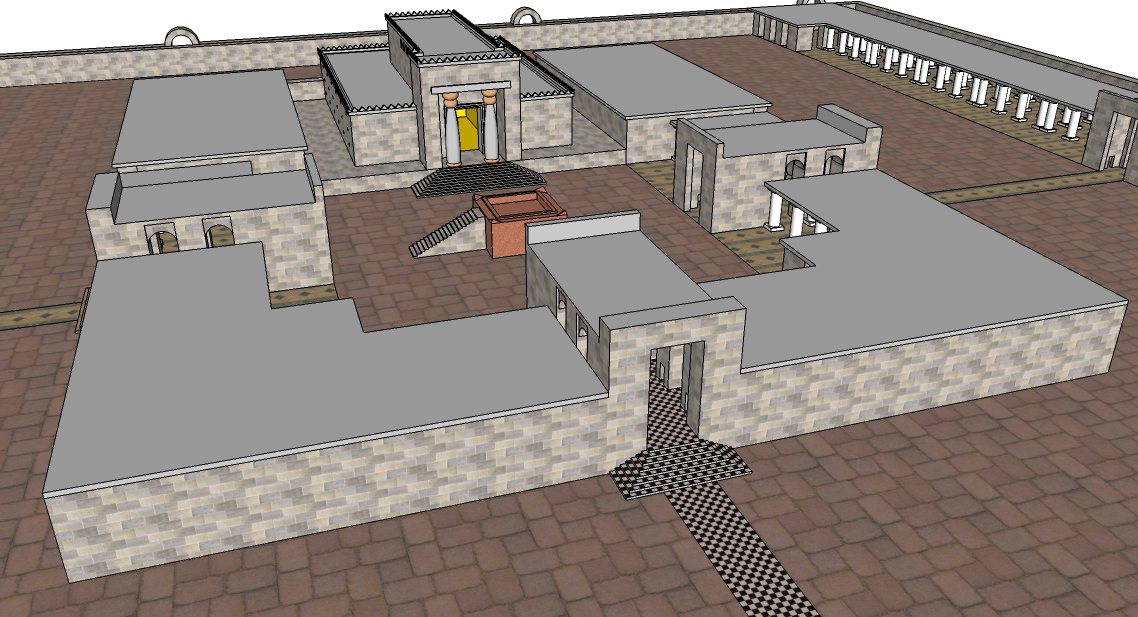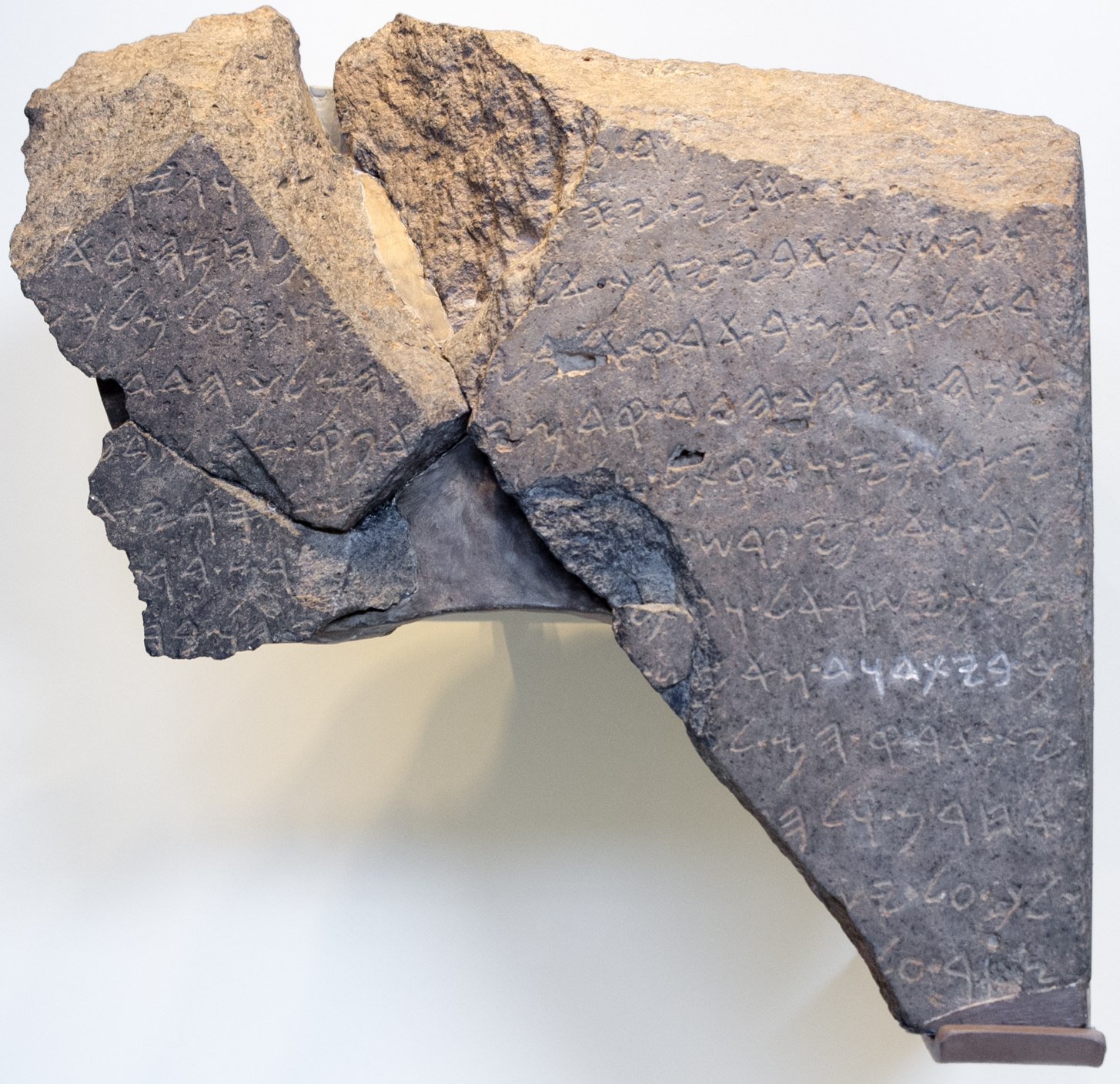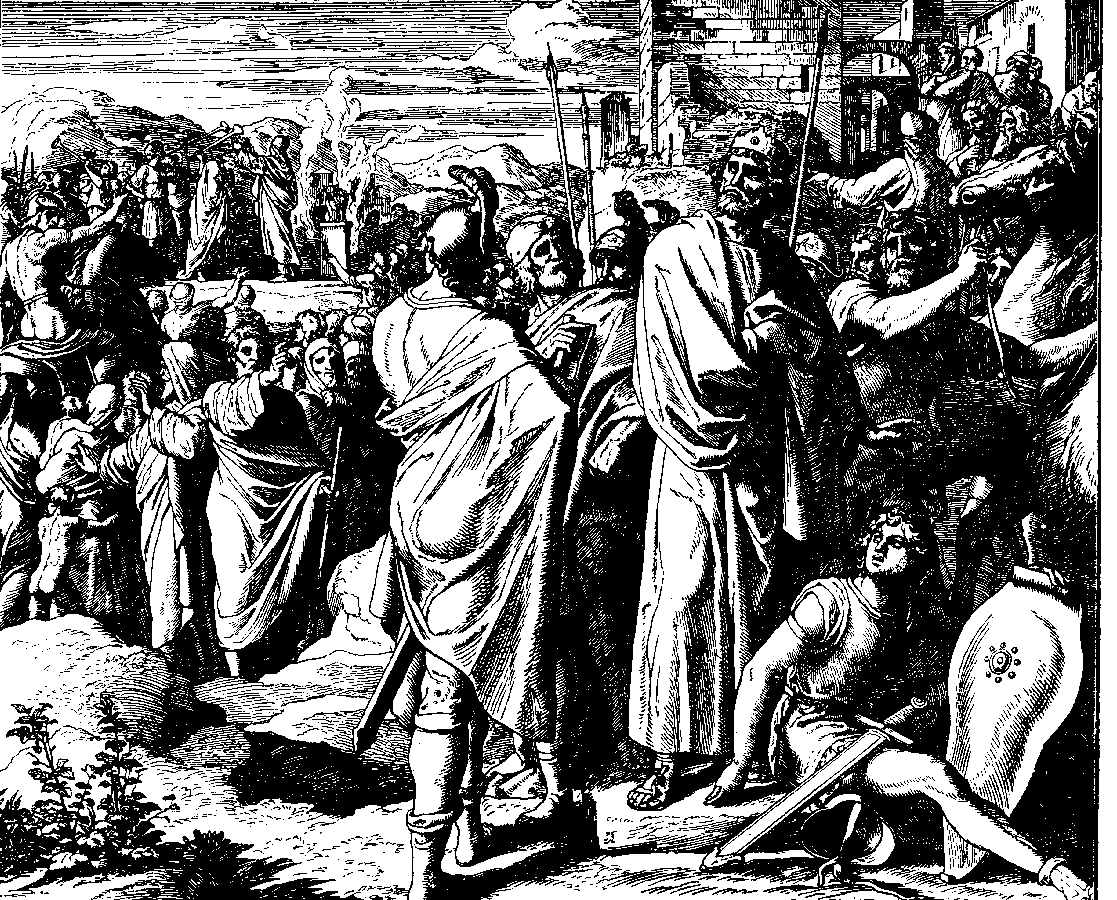|
Asaiah
Asaiah (Hebrew: עשיה "God made me") was the personal secretary of Josiah, king of Judah in the 7th century BCE, and according to the Bible (II Kings, Chapter 22, and Books of Chronicles 2, Chapter 34), is one of Josiah's deputation to the prophet Huldah. A seal with the text ''Asayahu servant of the king'' probably belonged to him.Heltzer, Michael, ''THE SEAL OF ˓AŚAYĀHŪ''. In Hallo, 2000, Vol. II p. 204 Other biblical figures * Asaiah (Simeonite) a prince of the tribe of Simeon who attacked and captured Gedor, and settled there (I Chron. iv. 36) * Asaiah (Levite) a Levite appointed to take part in bringing back the Ark of the Covenant (I Chron. vi. 15 . V. 30 xv. 6, 11) * Asaiah (Shilonite) a Shilonite residing in Jerusalem Jerusalem is a city in the Southern Levant, on a plateau in the Judaean Mountains between the Mediterranean Sea, Mediterranean and the Dead Sea. It is one of the List of oldest continuously inhabited cities, oldest cities in the world, and . ... [...More Info...] [...Related Items...] OR: [Wikipedia] [Google] [Baidu] |
Asaiah Ziv
Aaron Michael Rivera (born July 17, 1996) is an American rapper who goes by the stage name Asaiah Ziv (pronounced: Uh-sy-uh Zihv). Formerly known as KIDD or Tha Kidd Jopp, released his first studio album, ''Murder My Flesh'', on the Christian hip hop label Infiltrate Music in 2013, and was a ''Billboard'' chart breakthrough release. He subsequently released a free extended play in 2014, ''Hipsavvy: The Introduction'', also with Infiltrate . On February 1, 2016, Rapzilla, which is run by the owners of Infiltrate, revealed that Rivera no longer identified as a Christian, and that he was released from his contract. Biography Asaiah Ziv was born Aaron Michael Rivera on July 17, 1996, in Las Vegas, Nevada. He was born to a Puerto Rican father and a Hungarian mother. He was inspired by Lupe Fiasco to get involved in the music industry as shown in his song "Black Sheep ung Lupe. His music career started in 2011, yet his first release was ''Murder My Flesh'', with Infiltrate Mus ... [...More Info...] [...Related Items...] OR: [Wikipedia] [Google] [Baidu] |
Huldah
Huldah ( ''Ḥuldā'') is a prophetess mentioned in the Hebrew Bible in and . After the discovery of a book of the Law during renovations at Solomon's Temple, on the order of King Josiah, Hilkiah together with Ahikam, Acbor, Shaphan and Asaiah approach her to seek the Lord's opinion. She was the wife of Shallum son of Tokhath (also called Tikvah), son of Harhas (also called Hasrah), keeper of the wardrobe. She lived in Jerusalem, in the Second District or Second Quarter. The King James Version of the Bible calls this quarter "the college", and the New International Version calls it "the new quarter". According to Rabbinic interpretation, Huldah and Deborah were the principal professed woman prophets in the Nevi'im (Prophets) portion of the Hebrew Bible, although Miriam is referred to as such in the Torah and an unnamed prophetess is mentioned in Isaiah. "Huldah" derives from the Hebrew lemma חלד, meaning to abide or to continue. The Huldah Gates in the Southern W ... [...More Info...] [...Related Items...] OR: [Wikipedia] [Google] [Baidu] |
Josiah
Josiah () or Yoshiyahu was the 16th king of Judah (–609 BCE). According to the Hebrew Bible, he instituted major religious reforms by removing official worship of gods other than Yahweh. Until the 1990s, the biblical description of Josiah’s reforms were usually considered to be more or less accurate, but that is now heavily debated. According to the Bible, Josiah became king of the Kingdom of Judah at the age of eight, after the assassination of his father, King Amon, and reigned for 31 years, from 641/640 to 610/609 BCE. Josiah is known only from biblical texts; no reference to him exists in other surviving texts of the period from ancient Egypt or Babylon, and no clear archaeological evidence, such as inscriptions bearing his name, has ever been found. However, a seal bearing the name " Nathan-melech," the name of an administrative official under King Josiah according to , dating to the 7th century BCE, was found in situ in an archeological site in Jerusalem. The discov ... [...More Info...] [...Related Items...] OR: [Wikipedia] [Google] [Baidu] |
Kingdom Of Judah
The Kingdom of Judah was an Israelites, Israelite kingdom of the Southern Levant during the Iron Age. Centered in the highlands to the west of the Dead Sea, the kingdom's capital was Jerusalem. It was ruled by the Davidic line for four centuries. Jews are named after Judah, and primarily descend from people who lived in the region. The Hebrew Bible depicts the Kingdom of Judah as one of the two successor states of the Kingdom of Israel (united monarchy), United Kingdom of Israel, a term denoting the united monarchy under biblical kings Saul, David, and Solomon and covering the territory of Judah and Kingdom of Israel (Samaria), Israel. However, during the 1980s, Biblical minimalism, some biblical scholars began to argue that the archaeological evidence for an extensive kingdom before the late 8th century BCE is too weak, and that the methodology used to obtain the evidence is flawed. In the 10th and early 9th centuries BCE, the territory of Judah might have been limited ... [...More Info...] [...Related Items...] OR: [Wikipedia] [Google] [Baidu] |
Bible
The Bible is a collection of religious texts that are central to Christianity and Judaism, and esteemed in other Abrahamic religions such as Islam. The Bible is an anthology (a compilation of texts of a variety of forms) originally written in Hebrew, Aramaic, and Koine Greek. The texts include instructions, stories, poetry, prophecies, and other genres. The collection of materials accepted as part of the Bible by a particular religious tradition or community is called a biblical canon. Believers generally consider it to be a product of divine inspiration, but the way they understand what that means and interpret the text varies. The religious texts were compiled by different religious communities into various official collections. The earliest contained the first five books of the Bible, called the Torah in Hebrew and the Pentateuch (meaning 'five books') in Greek. The second-oldest part was a collection of narrative histories and prophecies (the Nevi'im). The third co ... [...More Info...] [...Related Items...] OR: [Wikipedia] [Google] [Baidu] |
Books Of Kings
The Book of Kings (, ''Sefer (Hebrew), Sēfer Malik, Məlāḵīm'') is a book in the Hebrew Bible, found as two books (1–2 Kings) in the Old Testament of the Christian Bible. It concludes the Deuteronomistic history, a history of ancient Israel also including the books of Book of Joshua, Joshua, Book of Judges, Judges, and Books of Samuel, Samuel. Biblical commentators believe the Books of Kings mixes legends, folktales, miracle stories and "fictional constructions" in with the annals for the purpose of providing a Theology, theological explanation for the Siege of Jerusalem (587 BC), destruction of the Kingdom of Judah by Babylon in c. 586 BC and to provide a foundation for a return from Babylonian captivity, Babylonian exile.Sweeney, p1/ref> The two books of Kings present a history of ancient Israel and Judah, from the death of King David to the release of Jehoiachin from imprisonment in Babylon—a period of some 400 years (). Scholars tend to treat the books as cons ... [...More Info...] [...Related Items...] OR: [Wikipedia] [Google] [Baidu] |
Books Of Chronicles
The Book of Chronicles ( , "words of the days") is a book in the Hebrew Bible, found as two books (1–2 Chronicles) in the Christian Old Testament. Chronicles is the final book of the Hebrew Bible, concluding the third section of the Jewish Tanakh, the Ketuvim ("Writings"). It contains a genealogy starting with Adam and a history of ancient Judah and Israel up to the Edict of Cyrus in 539 BC. The book was translated into Greek and divided into two books in the Septuagint in the mid-3rd century BC. In Christian contexts Chronicles is referred to in the plural as the Books of Chronicles, after the Latin name given to the text by Jerome, but is also referred to by its Greek name as the Books of Paralipomenon. In Christian Bibles, they usually follow the two Books of Kings and precede Ezra–Nehemiah, the last history-oriented book of the Protestant Old Testament. Summary The Chronicles narrative begins with Adam, Seth and Enosh, and the story is then carried forward, almos ... [...More Info...] [...Related Items...] OR: [Wikipedia] [Google] [Baidu] |
Tribe Of Simeon
According to the Hebrew Bible, the Tribe of Simeon (; ''Šīm‘ōn'', "hearkening/listening/understanding/empathizing") was one of the twelve tribes of Israel. The Book of Joshua locates its territory inside the boundaries of the Tribe of Judah (Joshua 19:9). It has been usually counted as one of the ten lost tribes, although its territory was surrounded by and gradually being absorbed by Judah from the start. For any Simeonites to be of the Northern Kingdom of Israel or to be affected by the Assyrian sack of the kingdom (future lost tribes) would imply a northward migration at some point in time, with support perhaps from 2 Chronicles (15:9 and 34:6,7). The biblical narrative has it coming into the Land of Israel following the Exodus, while scholarly reconstructions have offered a variety of opinions as to its origins and early history. From the Book of Genesis until the Babylonian captivity, the Bible provides various details about its history, after which point it disappears ... [...More Info...] [...Related Items...] OR: [Wikipedia] [Google] [Baidu] |
Levite
Levites ( ; ) or Levi are Jewish males who claim patrilineal descent from the Tribe of Levi. The Tribe of Levi descended from Levi, the third son of Jacob and Leah. The surname ''Halevi'', which consists of the Hebrew definite article "" ''Ha-'' ('the') plus ''Levi'' ('Levite'), is not conclusive regarding being a Levite; a titular use of HaLevi indicates being a Levite. The daughter of a Levite is a (''Bat'' being Hebrew for 'daughter'). The Tribe of Levi served particular religious duties for the Israelites and had political (administering cities of refuge) and educational responsibilities as well. In return, the landed tribes were expected to support the Levites with a tithe (), particularly the tithe known as the First tithe, ''ma'aser rishon''. The Kohanim, a subset of the Levites, were the priests, who performed the work of holiness in the Temple. The Levites, referring to those who were not Kohanim, were specifically assigned to: * Singing and/or playing music in the T ... [...More Info...] [...Related Items...] OR: [Wikipedia] [Google] [Baidu] |
Ark Of The Covenant
The Ark of the Covenant, also known as the Ark of the Testimony or the Ark of God, was a religious storage chest and relic held to be the most sacred object by the Israelites. Religious tradition describes it as a wooden storage chest decorated in solid gold accompanied by an ornamental lid known as the mercy seat, Seat of Mercy. According to the Book of Exodus and Books of Kings, First Book of Kings in the Hebrew Bible and the Old Testament, the Ark contained the Tablets of Stone, Tablets of the Law, by which Yahweh, God delivered the Ten Commandments to Moses at Mount Sinai (Bible), Mount Sinai. According to the Book of Exodus, the Book of Numbers, and the Epistle to the Hebrews in the New Testament, it also contained Aaron's rod and a pot of manna. The biblical account relates that approximately one year after the Israelites' The Exodus, exodus from Egypt, the Ark was created according to the pattern that God gave to Moses when the Israelites were encamped at the foot of Mou ... [...More Info...] [...Related Items...] OR: [Wikipedia] [Google] [Baidu] |







